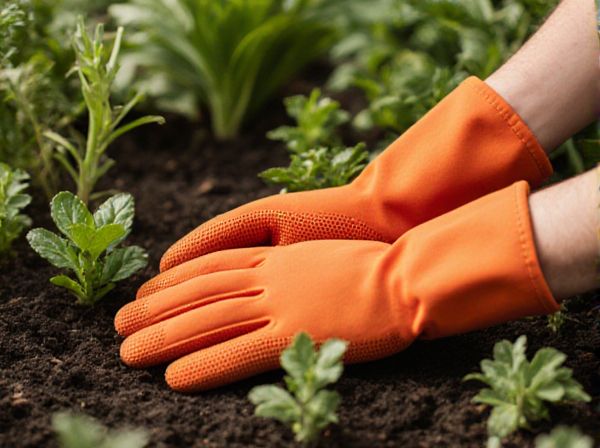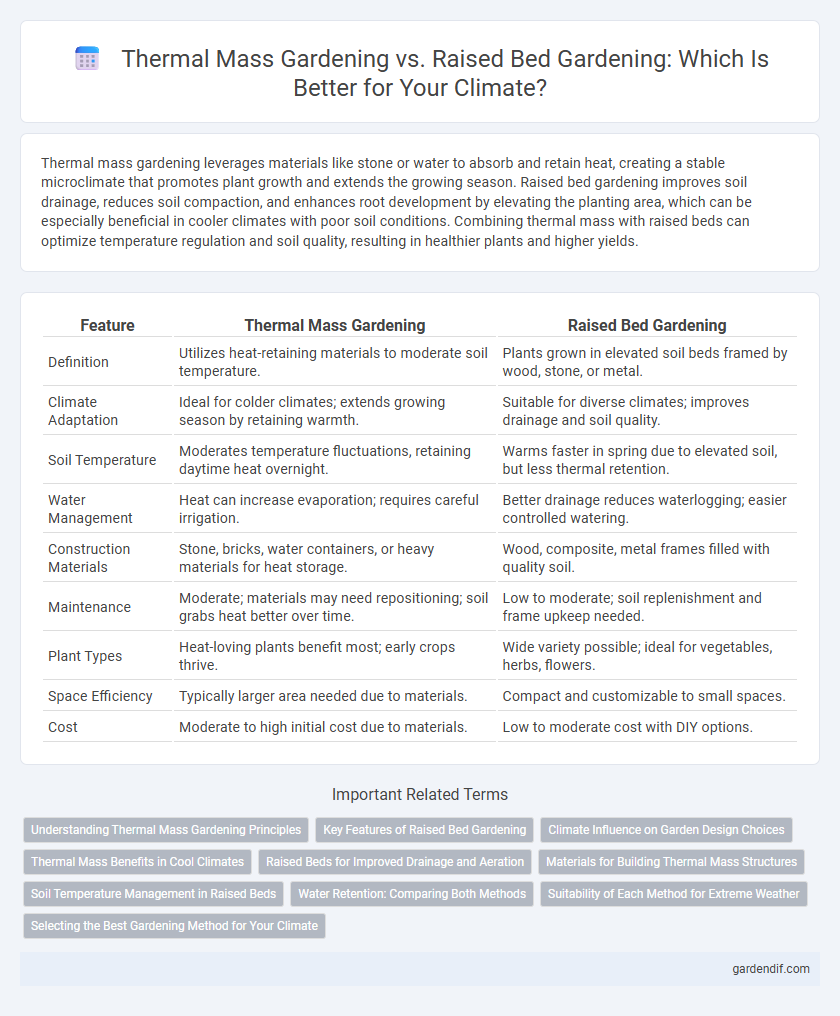
Thermal mass gardening vs Raised bed gardening Illustration
Thermal mass gardening leverages materials like stone or water to absorb and retain heat, creating a stable microclimate that promotes plant growth and extends the growing season. Raised bed gardening improves soil drainage, reduces soil compaction, and enhances root development by elevating the planting area, which can be especially beneficial in cooler climates with poor soil conditions. Combining thermal mass with raised beds can optimize temperature regulation and soil quality, resulting in healthier plants and higher yields.
Table of Comparison
| Feature | Thermal Mass Gardening | Raised Bed Gardening |
|---|---|---|
| Definition | Utilizes heat-retaining materials to moderate soil temperature. | Plants grown in elevated soil beds framed by wood, stone, or metal. |
| Climate Adaptation | Ideal for colder climates; extends growing season by retaining warmth. | Suitable for diverse climates; improves drainage and soil quality. |
| Soil Temperature | Moderates temperature fluctuations, retaining daytime heat overnight. | Warms faster in spring due to elevated soil, but less thermal retention. |
| Water Management | Heat can increase evaporation; requires careful irrigation. | Better drainage reduces waterlogging; easier controlled watering. |
| Construction Materials | Stone, bricks, water containers, or heavy materials for heat storage. | Wood, composite, metal frames filled with quality soil. |
| Maintenance | Moderate; materials may need repositioning; soil grabs heat better over time. | Low to moderate; soil replenishment and frame upkeep needed. |
| Plant Types | Heat-loving plants benefit most; early crops thrive. | Wide variety possible; ideal for vegetables, herbs, flowers. |
| Space Efficiency | Typically larger area needed due to materials. | Compact and customizable to small spaces. |
| Cost | Moderate to high initial cost due to materials. | Low to moderate cost with DIY options. |
Understanding Thermal Mass Gardening Principles
Thermal mass gardening utilizes materials like stone, water, or concrete that absorb and store heat during the day, releasing it slowly at night to moderate temperature fluctuations and extend growing seasons. This method enhances microclimate stability, reduces frost risk, and optimizes energy efficiency in plant growth. Understanding thermal mass principles enables gardeners to create resilient ecosystems by leveraging natural heat regulation contrasts compared to raised bed gardening, which primarily improves soil drainage and root aeration without significant heat retention.
Key Features of Raised Bed Gardening
Raised bed gardening offers enhanced soil drainage and improved root aeration, which promotes healthier plant growth compared to traditional in-ground methods. It allows for precise soil composition control, enabling gardeners to optimize nutrient levels and pH for specific crops. Elevated beds reduce soil compaction and facilitate easier pest management, making them ideal for climate-adaptive gardening strategies.
Climate Influence on Garden Design Choices
Thermal mass gardening leverages materials like stone or water to absorb and retain heat, moderating temperature fluctuations in climates with significant diurnal variation. Raised bed gardening improves soil drainage and aeration, making it ideal for regions with heavy rainfall or poor native soil conditions. Climatic factors such as temperature extremes and precipitation levels directly influence the selection between thermal mass and raised bed methods to optimize plant growth and sustainability.
Thermal Mass Benefits in Cool Climates
Thermal mass gardening leverages materials like stone, brick, or water containers to absorb and store heat, providing consistent warmth to plants during cold nights and extending the growing season in cool climates. This method stabilizes soil temperature fluctuations, reducing frost risk and promoting healthier root development compared to raised bed gardening, which lacks significant thermal inertia. Enhanced heat retention supports early seed germination and sustained plant growth, making thermal mass gardening particularly effective for regions with variable or low temperatures.
Raised Beds for Improved Drainage and Aeration
Raised bed gardening enhances drainage and aeration by elevating soil above ground level, preventing waterlogging and promoting healthier root development. This method improves soil structure and oxygen availability, essential for optimal plant growth in various climates. Elevated beds also facilitate better temperature regulation and reduce soil compaction compared to thermal mass gardening.
Materials for Building Thermal Mass Structures
Thermal mass gardening utilizes materials such as concrete, bricks, and stones to absorb and store heat, providing temperature regulation and frost protection in garden beds. Raised bed gardening typically employs wood, composite lumber, and metal frames, which offer better soil drainage and prevent soil compaction but lack significant heat retention properties. Choosing high-density materials with thermal conductivity is critical for optimizing energy efficiency and microclimate control in thermal mass garden structures.
Soil Temperature Management in Raised Beds
Raised bed gardening offers superior soil temperature management by allowing the soil to warm up faster in spring due to better exposure and improved drainage compared to thermal mass gardening. The elevated structure of raised beds reduces soil compaction and promotes aeration, which enhances root development and microbial activity crucial for healthy plant growth. Optimizing soil temperature in raised beds extends the growing season and supports more consistent crop yields despite fluctuating climate conditions.
Water Retention: Comparing Both Methods
Thermal mass gardening enhances water retention by utilizing materials like stone or water tanks that absorb heat and slowly release moisture to plants, reducing evaporation and conserving soil moisture. Raised bed gardening improves drainage and prevents waterlogging but may require more frequent watering due to increased exposure to air and sun, potentially leading to faster drying of the soil. Combining thermal mass elements with raised beds can optimize water retention, promoting sustainable water use in climate-sensitive gardening.
Suitability of Each Method for Extreme Weather
Thermal mass gardening leverages materials like stone and water to absorb and slowly release heat, making it highly suitable for extreme temperature fluctuations by stabilizing microclimates and protecting plants from frost or heat stress. Raised bed gardening offers improved drainage and soil control, which is ideal for heavy rainfall or drought-prone regions, but it can be less effective in buffering temperature extremes compared to thermal mass gardens. Both methods enhance resilience in extreme weather conditions, with thermal mass gardening excelling in temperature regulation and raised beds providing superior soil management.
Selecting the Best Gardening Method for Your Climate
Thermal mass gardening leverages materials like stone and water to absorb and store heat, making it ideal for climates with significant temperature fluctuations between day and night. Raised bed gardening improves soil drainage and temperature control, which benefits regions with heavy rainfall or poor soil quality. Choosing the best method depends on local climate patterns, soil conditions, and the desired crops, ensuring optimal plant growth and resource efficiency.
Thermal mass gardening vs Raised bed gardening Infographic

 gardendif.com
gardendif.com